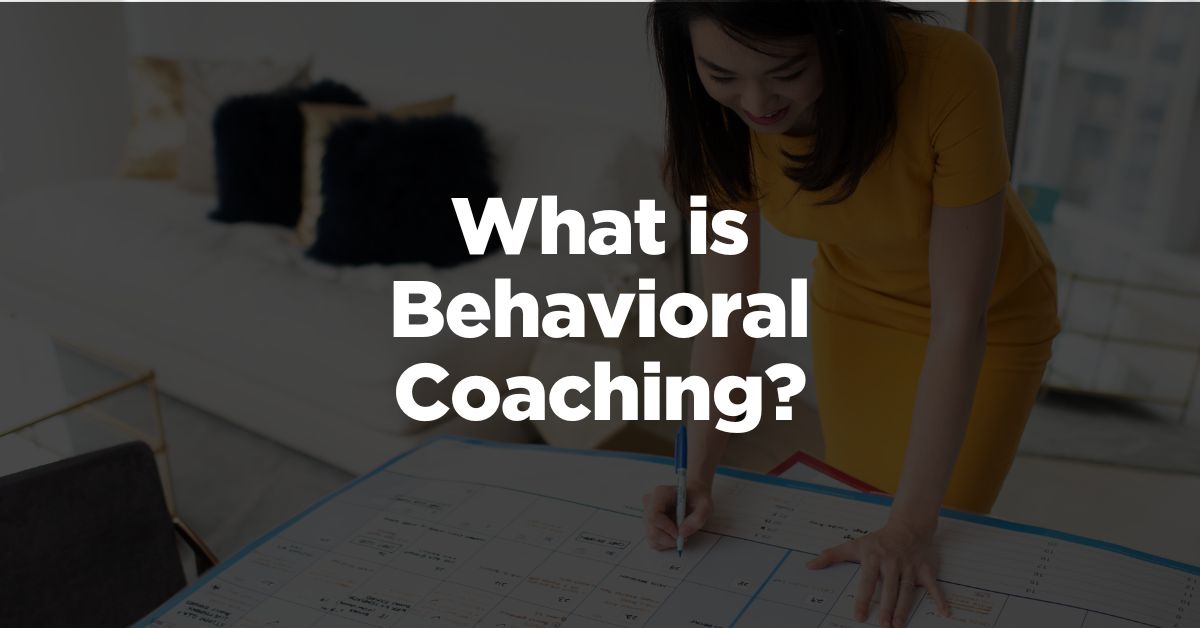Want to become a behavioral coach? Then you’re in the right place!
Below, I’ve gathered everything you need to know to become a successful behavioral coach.
Ready to start learning?
Let’s go!
You’ll learn:
- What behavioral coaching is
- The difference between behavioral coaching and behavioral therapy
- What a behavioral coach does
- The benefits of behavioral coaching
- How to become a behavioral coach
- How much behavioral coaches charge
What is behavioral coaching?
Let’s start with the basics:
What exactly is behavioral coaching?
Behavioral coaching is a type of life coaching that combines:
- Psychology
- Behavioral science
- Neuroplasticity
We’ll go over what neuroplasticity is in a bit. But in short, these three elements are super useful for getting to the cause of clients’ core problems.
You see, to create long-term changes in our lives, we first need to understand why we do what we do.
That’s where behavioral coaching comes in.
Get the Ultimate Guide
for building a
6-Figure Coaching Business so you can achieve more freedom!
Behavioral coaching is great for anyone who wants to:
- Create good habits
- Improve performance
- Overcome personal challenges
And it’s not just for individuals — companies use it too to help their teams perform better.
Next, let’s explore a key concept in understanding how behavioral coaching works: Neuroplasticity.
What is neuroplasticity?
Neuroplasticity is the brain’s ability to change and adapt.
Every time you do something, your brain starts getting the hang of it — like creating a shortcut.
Our brain loves saving energy, so it sticks to these patterns. But it also means unproductive or harmful habits can become deeply rooted.
In fact, around 40% to 90% of our behavior is done on autopilot.
The good news? Since most of our behavior is learned, it can also be unlearned.
That’s neuroplasticity in action.
By forming new habits, you create new neural pathways.
This is super important in behavioral coaching. It means you can help clients ditch bad habits and pick up healthier ones instead.
What is the difference between behavioral coaching and behavioral therapy?
You might wonder how behavioral coaching differs from behavioral therapy.
Let’s clear that up.
Here’s what you’ll be doing as a behavioral coach:
- Hold client-led coaching sessions that are driven by the client’s needs
- Focus on the present and future
- Set goals and help clients achieve them
- Build on clients’ strengths
- Ask the right questions to guide the coaching process
- And so on
And here’s what you WON’T be doing:
- Diagnose mental illness or traumatic stress orders
- Delve into deep-rooted psychological issues
As a behavioral coach, you don’t need any official certifications.
That’s different for behavioral therapists, though, who:
- Are qualified health professionals
- Can diagnose and treat mental illnesses
- Have had specific training and education
- Often focus on a client’s past, including trauma
- Are equipped to deal with complex psychological issues
As a behavioral coach, your role is more about guiding clients toward self-improvement. Your approach is very goal-driven as you focus on achieving specific outcomes.
A therapist, on the other hand, tends to dig deep into the past to resolve mental health issues.
Next up, let’s explore how you’ll be helping clients as a behavioral coach.
What does a behavioral coach do?
What will you be doing as a behavioral coach?
Let’s break it down:
- Clarify objectives: First, you need to understand your client’s vision for the future. What do they want to achieve?
- Set goals: Together with your client, you set achievable and meaningful goals. (I’ll share exactly why this matters later in this article.)
- Create action plans: Besides setting goals, you also develop actionable plans to actually achieve them.
- Recognize behavior patterns: You show clients how their actions affect their lives. And you identify and analyze their habits to pinpoint what needs changing.
The end goal? A real transformation that leads to a more fulfilling life.
To make this happen you’ll use different Cognitive Behavioral Coaching/Therapy Techniques:
- Positive psychology interventions: You focus on clients’ strengths, not just what they struggle with, to boost confidence and motivation.
- Motivational interviewing: You help clients find their personal ‘why’ behind the changes they want to make. Then, you guide them to make those changes themselves.
- Reframing: You help clients develop more constructive viewpoints. You show them how to find new solutions and how to turn obstacles into growing opportunities.
- Experiential learning: Learning by doing is so much more powerful than just talking about it. You encourage clients to try out new behaviors AND create opportunities to experiment. This can be through real tasks or practice activities.
These techniques don’t create just temporary change — they give your clients the tools to keep growing on their own.
That’s the real transformation.
Now that you have an idea what your role will be, let’s look at why someone might hire a behavioral coach.
What’s in it for them?
What are the benefits of hiring a behavioral coach?
Curious about the impact you’ll make as a behavioral coach?
Here’s what you can offer your clients:
- Building confidence
- Personal growth
- Better decision-making
- Easing mental load
- Improving relationships
- Finding purpose
- More self-awareness
- Problem-solving strategies
- Healthier lifestyle
- Developing emotional intelligence
- Better work-life balance
- And so on
In other words, you can have a huge impact and help clients change their lives.
Want to know how to get started?
Let’s go over it.
How to become a behavioral coach
Becoming a successful behavioral coach isn’t too complicated.
It all comes down to the right strategy and following the right steps.
There are five important steps you’ll have to follow.
Here’s what each one involves.
Find a niche
The first step is finding your niche or specialization.
This could be personal growth, corporate coaching, or even financial behavior.
Specializing helps you:
- Become the go-to coach: Focusing on a particular area sets you apart as the expert in that field.
- Draw in the right audience: Clients seek you out because your expertise aligns with their needs.
- Improve your skills: By diving deeper, you sharpen your skills in that area.
- Find more clients: Happy clients are likely to spread the word, which helps you find more clients.
- Increase your rates: With targeted coaching, you deliver results quickly. That’s what clients hire you for, and they’re willing to pay for it.
Deciding on your niche means asking yourself some questions:
- What are you good at and have experience in?
- Who do you want to help?
- What problems do you want to solve?
Maybe you have corporate experience and see yourself coaching future business leaders. Or you’re creative and want to help other creatives.
Or perhaps you feel drawn to help clients with habit formation, life transitions, or communication skills?
Your niche is where your strengths and the needs of potential clients come together.
Unsure about your niche? This video will clear things up:
Get a behavioral coaching certification
First of all, a certification is not a MUST-have to be a great coach.
What matters most is how good you are at helping your clients see the results they’re after.
This requires a lot of practice.
And it’s why I generally advise my students to start coaching ASAP.
Because the more you coach, the better you get at it.
That said, some niches like health and mental health coaching do have stricter rules. So, always look up the specific regulations in your state.
Not sure what your options are when it comes to behavioral coaching certifications?
Here are two great programs:
- Wellness Workdays – Certified Behavioral Health & Wellness Coach Certification: This option is ideal if you’re interested in corporate coaching. It includes on-demand video training and live courses with flexible timing. You’ll learn to conduct one-on-one and group health coaching sessions. To apply, you need a degree in a related field and/or national certification. (Cost: $699.)
- PeopleKeys – Certified Behavioral Life Coach: This program uses the DISC system — a tool that helps understand behavior styles. First, you dive into behavioral analysis. Then, you choose between two second-level courses. One focuses on practical DISC applications in business, while the other has a Christian-based approach. All training is self-paced and online, with some live webinars. (Cost: $1,190 — $695 for level one and $495 for level two.)
Get the Ultimate Guide
for building a
6-Figure Coaching Business so you can achieve more freedom!
After looking into certifications, your next task is to set up your packages.
Build a behavioral coaching package
I always teach my students to work with packages.
Why?
It shifts attention to the outcomes your clients will see, rather than just the amount of hours you put in.
Here’s a straightforward way to set up your coaching package:
1. Focus on the outcome: Highlight the changes your clients will experience. This shifts their attention from hourly costs to the real value they’ll gain by working with you.
2. Begin with a three-month program: This length is perfect for seeing real change without feeling too long. It’s also a good period to see if you and the client work well together.
3. Regular but spaced-out sessions: I recommend bi-weekly coaching sessions with regular email support. This timing allows your clients to apply what they learn and see the results.
4. Pricing your package: A starting price of around $1,500 is a good balance. It’s affordable for clients but also values your service. As you gain more experience and testimonials, you can gradually increase your rates. For example, most of my students charge +$5,000 for their coaching services.
Once you’ve got your coaching package ready, it’s time to find those clients who need what you offer.
Get behavioral coaching clients
To start coaching, you need your first client.
Yes, just ONE for now.
Offer that first client a transformative experience. And only then move on to the next.
This approach helps you avoid the trap many new coaches fall into:
Setting unrealistic goals that only lead to disappointment.
Not sure how to find that first paying client? Here are some great strategies:
- Your network: Start with people you already know. Maybe someone in your network would like to work with you, or they know someone who could use behavioral coaching.
- Social media: Build relationships and engage with people on social media. The trick is to focus on the platform where your target audience is most active. Master that platform before expanding to the next one.
- Podcasts: Get featured on podcasts or start your own. This lets you delve deeper into topics and gives you the chance to showcase your expertise.
For extra help with your first client, check out my video:
Work with behavioral coaching client
The fifth step is coaching your client.
To call your coaching successful, you need to offer a genuine transformation.
Here’s a great formula to make this happen:
- Establish the main goal(s) you’ll be working toward
- Break this main goal down into smaller milestones
- Divide these milestones into subgoals for each coaching session
Why work with goals?
They trigger new behaviors and tell you what to focus on.
In each coaching session, you tackle one or two specific subgoals.
This makes the process manageable and lets your client see real progress.
For more insights on setting the right goals, check out this video I put together for you:
You now know what it takes to become a behavioral coach. But how much will you be earning?
Let’s take a closer look…
How much does a behavioral coach charge?
How much a behavioral coach charges depends on their niche and experience.
Glassdoor puts the average behavioral coaching salary in the US at about $64,000 annually, with a range of $51K – $80K.
Does that mean you can’t earn more than that?
Definitely NOT.
Get the Ultimate Guide
for building a
6-Figure Coaching Business so you can achieve more freedom!
You see, being your own boss comes with a special bonus: you get to set your own rates.
This type of business offers not just a great income, but also freedom — the freedom to shape your career and life on your terms.
Many of my own students in various coaching niches make six figures, multiple six figures, or more every year, while working less than they did in their corporate jobs and having more time for the things that really matter to them.
Next steps
And there you have it — your roadmap to becoming a behavioral coach.
Coaching is a great way to build a Freedom Business and quit your day job.
However, taking your coaching business to the six-figure mark can feel…well, impossible.
Want the simplest strategy for building a six-figure coaching business?
Get my six-figure coaching business blueprint, which lays out exactly how to build a highly successful coaching business.

Want to Build a 6-Figure Coaching Business So You Can Achieve More Freedom?
When you sign up, you’ll also receive regular updates on building a successful online business.
Read more:
The Definitive Starting a Coaching Business Checklist
How to Market Your Coaching Business
How to Become a 6-Figure Mindset Coach








